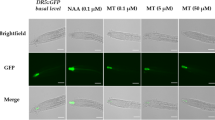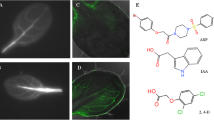Abstract
The chemical 2,4-dichlorophenoxyacetic acid (2,4-D) regulates plant growth and development and mimics auxins in exhibiting a biphasic mode of action. Although gene regulation in response to the natural auxin indole acetic acid (IAA) has been examined, the molecular mode of action of 2,4-D is poorly understood. Data from biochemical studies, (Grossmann (2000) Mode of action of auxin herbicides: a new ending to a long, drawn out story. Trends Plant Sci 5:506–508) proposed that at high concentrations, auxins and auxinic herbicides induced the plant hormones ethylene and abscisic acid (ABA), leading to inhibited plant growth and senescence. Further, in a recent gene expression study (Raghavan et al. (2005) Effect of herbicidal application of 2,4-dichlorophenoxyacetic acid in Arabidopsis. Funct Integr Genomics 5:4–17), we have confirmed that at high concentrations, 2,4-D induced the expression of the gene NCED1, which encodes 9-cis-epoxycarotenoid dioxygenase, a key regulatory enzyme of ABA biosynthesis. To understand the concentration-dependent mode of action of 2,4-D, we further examined the regulation of whole genome of Arabidopsis in response to a range of 2,4-D concentrations from 0.001 to 1.0 mM, using the ATH1-121501 Arabidopsis whole genome microarray developed by Affymetrix. Results of this study indicated that 2,4-D induced the expression of auxin-response genes (IAA1, IAA13, IAA19) at both auxinic and herbicidal levels of application, whereas the TIR1 and ASK1 genes, which are associated with ubiquitin-mediated auxin signalling, were down-regulated in response to low concentrations of 2,4-D application. It was also observed that in response to low concentrations of 2,4-D, ethylene biosynthesis was induced, as suggested by the up-regulation of genes encoding 1-aminocyclopropane-1-carboxylic acid (ACC) synthase and ACC oxidase. Although genes involved in ethylene biosynthesis were not regulated in response to 0.1 and 1.0 mM 2,4-D, ethylene signalling was induced as indicated by the down-regulation of CTR1 and ERS, both of which play a key role in the ethylene signalling pathway. In response to 1.0 mM 2,4-D, both ABA biosynthesis and signalling were induced, in contrast to the response to lower concentrations of 2,4-D where ABA biosynthesis was suppressed. We present a comprehensive model indicating a molecular mode of action for 2,4-D in Arabidopsis and the effects of this growth regulator on the auxin, ethylene and abscisic acid pathways.



Similar content being viewed by others
Abbreviations
- 2,4-D:
-
2,4-Dichlorophenoxyacetic acid
- ABA:
-
abscisic acid
- IAA:
-
indole acetic acid
- NAA:
-
naphthalene acetic acid
- TAIR:
-
The Arabidopsis Information Resources
References
Abel S, Theologis A (1996) Early genes and auxin action. Plant Physiol 111:9–17
Affymetrix (2002a) GeneChip expression analysis. Technical note
Affymetrix (2002b) Statistical algorithms description document. Technical note
Alonso JM, Stepanova AN (2004) The ethylene signaling pathway. Science 306:1513–1515
Arteca JM, Arteca RN (1999) A multi-responsive gene encoding 1-aminocyclopropane-1-carboxylate synthase (ACS6) in mature Arabidopsis leaves. Plant Mol Biol 39:209–219
Audran C, Borel C, Frey A, Sotta B, Meyer C, Simonneau T, Marion-Poll A (1998) Expression studies of the zeaxanthin epoxidase gene in Nicotiana plumbaginifolia. Plant Physiol 118:1021–1028
Becker D, Hedrich R (2002) Channelling auxin action: modulation of ion transport by indole-3-acetic acid. Plant Mol Biol 49:349–356
Bennett MJ, Marchant A, May ST, Swarup R (1998) Going the distance with auxin: unravelling the molecular basis of auxin transport. Philos Trans R Soc Lond B Biol Sci 353:1511–1515
Boyes DC, Zayed AM, Ascenzi R, McCaskill AJ, Hoffman NE, Davis KR, Gorlach J (2001) Growth stage-based phenotypic analysis of Arabidopsis: a model for high throughput functional genomics in plants. Plant Cell 13:1499–1510
Chang C (2003) Ethylene signalling: the MAPK module has finally landed. Trends Plant Sci 8:365–368
Chang C, Shockey JA (1999) The ethylene-response pathway: signal perception to gene regulation. Curr Opin Plant Biol 2:352–358
Chen CN, Chu CC, Zentella R, Pan SM, Ho TH (2002a) AtHVA22 gene family in Arabidopsis: phylogenetic relationship, ABA and stress regulation, and tissue-specific expression. Plant Mol Biol 49:633–644
Chen W, Provart NJ, Glazebrook J, Katagiri F, Chang H-S, Eulgem T, Mauch F, Luan S, Zou G, Whitham SA, Budworth PR, Tao Y, Xie Z, Chen X, Lam S, Kreps JA, Harper JF, Si-Ammour A, Mauch-Mani B, Heinlein M, Kobayashi K, Hohn T, Dangl JL, Wang X, Zhu T (2002b) Expression profile matrix of Arabidopsis transcription factor genes suggests their putative functions in response to environmental stresses. Plant Cell 14:559–574
Choi H, Hong J, Ha J, Kang J, Kim SY (2000) ABFs, a family of ABA-responsive element binding factors. J Biol Chem 275:1723–1730
Cutler AJ, Krochko JE (1999) Formation and breakdown of ABA. Trends Plant Sci 4:472–478
del Pozo JC, Estelle M (2000) F-box proteins and protein degradation: an emerging theme in cellular regulation. Plant Mol Biol 44:123–128
Dharmasiri S, Estelle M (2002) The role of regulated protein degradation in auxin response. Plant Mol Biol 49:401–409
Dharmasiri N, Dharmasiri S, Estelle M (2005) The F-box protein TIR1 is an auxin receptor. Nature 435:441–445
Farras R, Ferrando A, Jasik J, Kleinow T, Okresz L, Tiburcio A, Salchert K, del Pozo C, Schell J, Koncz C (2001) SKP1-SnRK protein kinase interactions mediate proteasomal binding of a plant SCF ubiquitin ligase. Embo J 20:2742–2756
Fujimoto SY, Ohta M, Usui A, Shinshi H, Ohme-Takagi M (2000) Arabidopsis ethylene-responsive element binding factors act as transcriptional activators or repressors of GCC box-mediated gene expression. Plant Cell 12:393–404
Gao Z, Chen YF, Randlett MD, Zhao XC, Findell JL, Kieber JJ, Schaller GE (2003) Localization of the Raf-like kinase CTR1 to the endoplasmic reticulum of Arabidopsis through participation in ethylene receptor signalling complexes. J Biol Chem 278:34725–34732
Grabinska-Sota EE, Wisniowska E, Kalka J (2003) Toxicity of selected synthetic auxines-2,4-D and MCPA derivatives to broad-leaved and cereal plants. Crop Prot 22:355–360
Gray WM, del Pozo JC, Walker L, Hobbie L, Risseeuw E, Banks T, Crosby WL, Yang M, Ma H, Estelle M (1999) Identification of an SCF ubiquitin-ligase complex required for auxin response in Arabidopsis thaliana. Genes Dev 13:1678–1691
Grossmann K (1996) A role for cyanide, derived from ethylene biosynthesis, in the development of stress symptoms. Physiol Plant 97:772–775
Grossmann K (2000) Mode of action of auxin herbicides: a new ending to a long, drawn out story. Trends Plant Sci 5:506–508
Guo H, Ecker JR (2004) The ethylene signalling pathway: new insights. Curr Opin Plant Biol 7:40–49
Hagen G, Guilfoyle T (2002) Auxin-responsive gene expression: genes, promoters and regulatory factors. Plant Mol Biol 49:373–385
Hall AE, Findell JL, Schaller GE, Sisler EC, Bleecker AB (2000) Ethylene perception by the ERS1 protein in Arabidopsis. Plant Physiol 123:1449–1458
Hansen H, Grossmann K (2000) Auxin-induced ethylene triggers abscisic acid biosynthesis and growth inhibition. Plant Physiol 124:1437–1448
Himmelbach A, Yang Y, Grill E (2003) Relay and control of abscisic acid signalling. Curr Opin Plant Biol 6:470–479
Hoth S, Morgante M, Sanchez JP, Hanafey MK, Tingey SV, Chua NH (2002) Genome-wide gene expression profiling in Arabidopsis thaliana reveals new targets of abscisic acid and largely impaired gene regulation in the abi1-1 mutant. J Cell Sci 115:4891–4900
Hua J, Sakai H, Nourizadeh S, Chen QG, Bleecker AB, Ecker JR, Meyerowitz EM (1998) EIN4 and ERS2 are members of the putative ethylene receptor gene family in Arabidopsis. Plant Cell 10:1321–1332
Huang Y, Li H, Hutchison CE, Laskey J, Kieber JJ (2003) Biochemical and functional analysis of CTR1, a protein kinase that negatively regulates ethylene signalling in Arabidopsis. Plant J 33:221–233
Jain M, Kaur N, Tyagi AK, Khurana JP (2005) The auxin-responsive GH3 gene family in rice (Oryza sativa). Funct Integr Genomics (online first). DOI 10.1007/s10142-005-0142-5
Kepinski S, Leyser O (2002) Ubiquitination and auxin signalling: a degrading story. Plant Cell 14(Suppl):S81–S95
Kepinski S, Leyser O (2005) The Arabidopsis F-box protein TIR1 is an auxin receptor. Nature 435:446–451
Leung J, Merlot S, Giraudat J (1997) The Arabidopsis ABSCISIC ACID-INSENSITIVE2 (ABI2) and ABI1 genes encode homologous protein phosphatases 2C involved in abscisic acid signal transduction. Plant Cell 9:759–771
Leyser O (2001) Auxin signalling: the beginning, the middle and the end. Curr Opin Plant Biol 4:382–386
Leyser O (2002) Molecular genetics of auxin signalling. Annu Rev Plant Biol 53:377–398
Liang X, Abel S, Keller JA, Shen NF, Theologis A (1992) The 1-aminocyclopropane-1-carboxylate synthase gene family of Arabidopsis thaliana. Proc Natl Acad Sci U S A 89:11046–11050
Marchant A, Bhalerao R, Casimiro I, Eklof J, Casero PJ, Bennett M, Sandberg G (2002) AUX1 promotes lateral root formation by facilitating indole-3-acetic acid distribution between sink and source tissues in the Arabidopsis seedling. Plant Cell 14:589–597
Merlot S, Gosti F, Guerrier D, Vavasseur A, Giraudat J (2001) The ABI1 and ABI2 protein phosphatases 2C act in a negative feedback regulatory loop of the abscisic acid signalling pathway. Plant J 25:295–303
Meyer K, Leube MP, Grill E (1994) A protein phosphatase 2C involved in ABA signal transduction in Arabidopsis thaliana. Science 264:1452–1455
Ouaked F, Rozhon W, Lecourieux D, Hirt H (2003) A MAPK pathway mediates ethylene signalling in plants. Embo J 22:1282–1288
Qin X, Zeevaart JA (1999) The 9-cis-epoxycarotenoid cleavage reaction is the key regulatory step of abscisic acid biosynthesis in water-stressed bean. Proc Natl Acad Sci U S A 96:15354–15361
Raghavan C, Ong EK, Dalling MJ, Stevenson TW (2005) Effect of herbicidal application of 2,4-dichlorophenoxyacetic acid in Arabidopsis. Funct Integr Genomics 5:4–17
Reed JW (2001) Roles and activities of Aux/IAA proteins in Arabidopsis. Trends Plant Sci 6:420–425
Riechmann JL, Meyerowitz EM (1998) The AP2/EREBP family of plant transcription factors. Biol Chem 379:633–646
Roux F, Gasquez J, Reboud X (2004) The dominance of the herbicide resistance cost in several Arabidopsis thaliana mutant lines. Genetics 166:449–460
Sato T, Theologis A (1989) Cloning the mRNA encoding 1-aminocyclopropane-1-carboxylate synthase, the key enzyme for ethylene biosynthesis in plants. Proc Natl Acad Sci U S A 86:6621–6625
Sawa S, Ohgishi M, Goda H, Higuchi K, Shimada Y, Yoshida S, Koshiba T (2002) The HAT2 gene, a member of the HD-Zip gene family, isolated as an auxin inducible gene by DNA microarray screening, affects auxin response in Arabidopsis. Plant J 32:1011–1022
Schaller GE, Kieber JJ (2002) Ethylene. In: Somerville CR, Meyerowitz EM (eds) The Arabidopsis book. American Society of Plant Biologists, Rockville, MD, pp 1–18
Schmidt R, Willmitzer L (1991) Arabidopsis regeneration and transformation (leaf and cotyledon explant system). Kluwer, Dordrecht, The Netherlands
Takahashi S, Katagiri T, Yamaguchi-Shinozaki K, Shinozaki K (2000) An Arabidopsis gene encoding a Ca2+-binding protein is induced by abscisic acid during dehydration. Plant Cell Physiol 41:898–903
Taylor IB, Burbidge A, Thompson AJ (2000) Control of abscisic acid synthesis. J Exp Bot 51:1563–1574
Timpte C, Lincoln C, Pickett FB, Turner J, Estelle M (1995) The AXR1 and AUX1 genes of Arabidopsis function in separate auxin-response pathways. Plant J 8:561–569
Wang KL, Li H, Ecker JR (2002) Ethylene biosynthesis and signalling networks. Plant Cell 14(Suppl):S131–S151
Wang W, Hall AE, O’Malley R, Bleecker AB (2003) Canonical histidine kinase activity of the transmitter domain of the ETR1 ethylene receptor from Arabidopsis is not required for signal transmission. Proc Natl Acad Sci U S A 100:352–357
Zarembinski TI, Theologis A (1994) Ethylene biosynthesis and action: a case of conservation. Plant Mol Biol 26:1579–1597
Acknowledgements
We would like to thank Nufarm Limited, Melbourne, Victoria, Australia, for the financial support.
This work was supported by Nufarm and an RMIT University VRI grant.
Author information
Authors and Affiliations
Corresponding author
Additional information
Experiment station: Plant Biotechnology Centre, Primary Industries Research Victoria, Department of Primary Industries, La Trobe University, Bundoora, Victoria 3086, and the Victorian Microarray Technology Consortium (VMTC).
Rights and permissions
About this article
Cite this article
Raghavan, C., Ong, E.K., Dalling, M.J. et al. Regulation of genes associated with auxin, ethylene and ABA pathways by 2,4-dichlorophenoxyacetic acid in Arabidopsis . Funct Integr Genomics 6, 60–70 (2006). https://doi.org/10.1007/s10142-005-0012-1
Received:
Revised:
Accepted:
Published:
Issue Date:
DOI: https://doi.org/10.1007/s10142-005-0012-1




